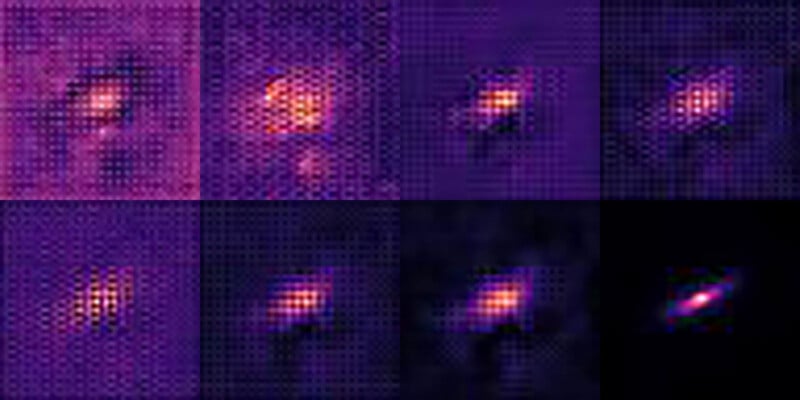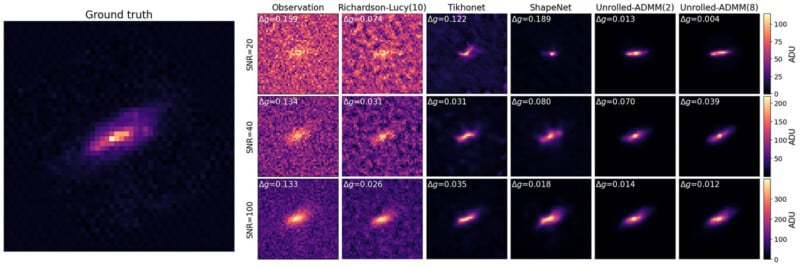Researchers Unveil Novel AI Algorithm That Can Unblur the Cosmos

While vital to humanity’s existence on Earth, the planet’s atmosphere is a major nuisance for astronomers trying to learn more about what’s beyond Earth. The cosmos would be much easier to study without the pesky atmosphere. Researchers at Northwestern University in Chicago and Tsinghua University in Beijing have unveiled a new artificial intelligence-powered approach to cleaning up images captured by ground-based telescopes.
The primary culprit behind blurry images is shifting pockets of air in the atmosphere. These air pockets can obfuscate the shapes of celestial bodies and can also affect the measurements scientists can make of distant objects, leading to incorrect conclusions.
Space-based telescopes, such as Hubble and the James Webb Space Telescope, avoid this issue altogether by leaving Earth’s atmosphere. However, space telescopes are monumentally expensive and always in high demand by astronomers.

Ground-based telescopes are easier to build, more affordable, and much simpler to fix when issues arise. To deal with the blur caused by the atmosphere, ground-based telescopes are often built in arid climates and at high altitudes. Even still, blur must be dealt with.
The light emanating from distant stars, planets, and galaxies travels a very long way to reach Earth. The light’s journey may encounter different gravitational effects, which can warp the light as observed from Earth. However, the light must also travel through Earth’s atmosphere before it reaches ground-based telescopes.
“Even clear night skies still contain moving air that affects light passing through it. That’s why stars twinkle and why the best ground-based telescopes are located at high altitudes where the atmosphere is thinnest,” Northwestern explains.
Alexander describes the effect as “a bit like looking up from the bottom of a swimming pool.” The atmosphere is much less dense than water, but the concept is similar.
![]()
The resulting blur is a significant problem for astrophysicists analyzing images for important cosmological data. The apparent shape of galaxies sheds light on large-scale cosmological structures and their gravitational effects.
“Slight differences in shape can tell us about gravity in the universe. These differences are already difficult to detect. If you look at an image from a ground-based telescope, a shape might be warped. It’s hard to know if that’s because of a gravitational effect or the atmosphere,” Alexander says.
If an image is blurry, it’s hard to conclude much about the shape of what’s being observed. By removing the blur precisely and mathematically, the true nature of distant objects can be measured and analyzed.
Scientists use numerous software-based approaches to process images to make them sharper and more useful. However, the new computer-vision algorithm, first seen on Space, approach promises better and faster results. The algorithm the team built has been explicitly adapted for processing astronomical images captured by ground-based telescopes, the first time such AI technology has been used for this purpose.
The team has trained the AI on data simulated to match the Vera C. Rubin Observatory, which will house the world’s largest digital camera when it opens next year in Chile. The new algorithm will be immediately compatible as soon as the telescope is ready for operations. It’s like the impressive observatory has received an upgrade before it even starts its stargazing.

“Photography’s goal is often to get a pretty, nice-looking image,” says Northwestern’s Emma Alexander, the study’s senior author. “But astronomical images are used for science. By cleaning up images in the right way, we can get more accurate data. The algorithm removes the atmosphere computationally, enabling physicists to obtain better scientific measurements. At the end of the day, the images do look better as well.”
Alexander is an assistant professor of computer science at Northwestern’s McCormick School of Engineering, where she leads the Bio Inspired Vision Lab. The new study was co-authored by Tianao Li, an undergraduate student in electrical engineering at Tsinghua University and a research intern in Alexander’s lab.
The team’s optimization algorithm, built upon a deep learning network trained on astronomical images, produces images with 38.6 percent less error than classic methods for removing blur and 7.4 percent less error compared to modern methods. That may not seem like a huge difference, but it is in the realm of astronomy. Relatively small improvements in accuracy and efficiency can have massive, far-reaching benefits to cutting-edge astronomy.
![]()
The tool is available completely open-source, ensuring that researchers worldwide can freely access and integrate it into their work. Alexander’s research will be published in the Monthly Notices of the Royal Astronomical Society.
“Now we pass off this tool, putting it into the hands of astronomy experts,” says Alexander. “We think this could be a valuable resource for sky surveys to obtain the most realistic data possible.”
Image credits: Emma Alexander/Northwestern University